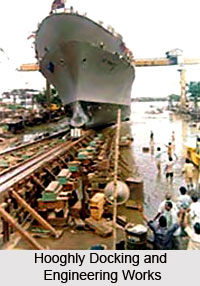 Howrah is economically prosperous and in the recent times it can compete with the other economically affluent district of the state. The economy of Howrah is predominantly industry dependent. Recently Howrah witnesses a lot of industrial proposals in its core.
Howrah is economically prosperous and in the recent times it can compete with the other economically affluent district of the state. The economy of Howrah is predominantly industry dependent. Recently Howrah witnesses a lot of industrial proposals in its core.
The location of Howrah is congenial for the economic growth of Howrah as well as the state. The city connected with Kolkata through Howrah Bridge (Rabindra Setu), Second Hooghly Bridge (Vidyasagar Setu) and Vivekananda Setu as well, constitute an effective road network. The Howrah station, one of the major rail stations in India, serves both Kolkata and Howrah. Hence the industrial development in Howrah is mainly due to the positional significance of the district.
The district is making economic progress with the mushrooming of both the small & large- scale industries. Salkia, in Howrah is the abode of the ship making industry in India. Hooghly Docking and Engineering Works (Salkia), Shalimar Works (Shibpur), Port Engineering Works (near to the Botanical Garden) etc are the traditional industries in the districts, established in the British regime. These industries supports the domestic economy and at the same time accounts for the large quantity of export while enhancing the overall economy of Howrah.
Though the market of jute is not pretty comfortable, still now there are about 20 jute mills here providing an ample scope of employment, thereby supporting the local economy of Howrah to a large extent. The first cotton mill of India had been established in Howrah in 1817, which is still in operation. Though the market of the jute and the cotton products produced in India, these small-scale industries support the domestic requirement providing economic stability to a group of individuals. However as the prospects of the jute industry is not at ease, the majority of the jute industries have been closed. The jute and cotton textile here are the government concerns, which are instrumental to grant the economic aid to the extremely poor folk.
T
The small-scale industries in Howrah are Government undertaken, which instead of being participating in the export business mainly supports the local economy by providing subsidiary parts to the domestic industries and offering employment to the natives. Ganges Rope factory at Shibpur, Shalimar paints, Eastern Railway Carriage and Wagon Workshop etc. are the factories of the above kind.
The key reason behind the expansion of the industries and their successful trading in the adjacent parts and even in the abroad was the construction of the Howrah Railway Terminus in 1854 and its well-organized network upto Mogalsarai.
The West Bengal State Government is planning to revitalize the industrial scenario of Howrah, thereby inducing rapid economic progress. With the collaboration of Department of International Development (DFID), a project for the economic development of Howrah is adopted. Recently the industrial proposals like the kona truck express and the logistic hub have been taken up in the district of Howrah. New industrial proposals in the town along with the reallocation of the foundry products have stimulated the economic upliftment of the district.
The economy of Howrah is no less supplemented by the agriculture. The regional topography, marked with uniform homogeneity, made up of fertile alluvium carried by the Bhagirathi in the eastern border and the Rupnarayan on the western border. The conducive landscape and the tropical climate augment the agricultural growth. Near about 75% of land is cultivated. Though rice is the principal crop, it mainly meets the local food demands. The pulses, oilseeds and potato cultivation mainly support the agricultural economy. The majority of these products are exported to the neighboring areas, which supports the economy greatly.




















